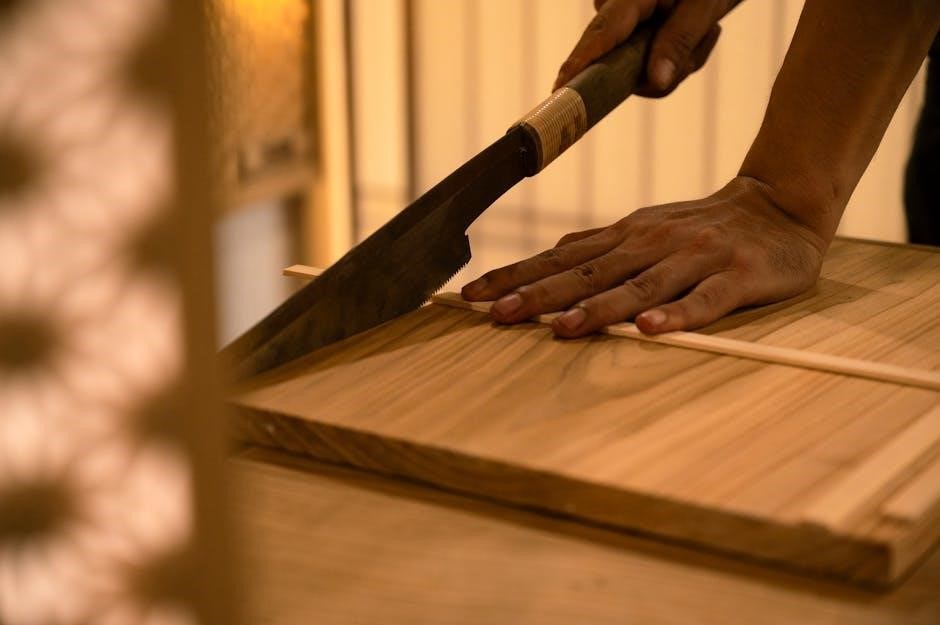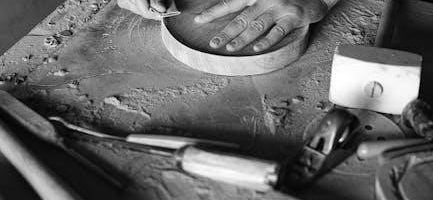Safety Precautions and Instructions
Always wear protective eyewear and keep loose clothing tied back. Ensure the blade guard is securely tightened. Never use the rip fence as a cutoff gauge. Use a push stick when ripping narrow stock. Keep hands away from the blade at all times. Turn off the saw before making adjustments or clearing debris. Follow all safety rules and operating instructions carefully to avoid injury.
- Ensure proper blade installation and alignment.
- Avoid overreaching; maintain firm control of materials.
- Never leave the saw unattended while operating.
- Keep children and bystanders away from the work area.
- Regularly inspect blades and guards for damage.
1.1 General Safety Guidelines
Always wear safety glasses and ensure loose clothing or jewelry is secured. Keep hands and fingers away from the saw blade at all times. Maintain a clean, well-lit workspace to minimize hazards. Avoid overreaching or leaning over the saw, as this can cause loss of control. Use a push stick or other safety devices when cutting small or narrow materials. Never allow children or unauthorized individuals near the saw. Ensure proper blade installation and alignment before operation. Regularly inspect blades and guards for damage or wear. Disconnect power before performing maintenance or adjustments. Follow all safety rules and operating instructions provided in the manual to reduce the risk of injury.
- Keep workpieces firmly secured against the miter gauge or rip fence.
- Avoid distractions while operating the saw.
- Ensure proper ventilation to prevent dust buildup.
1.2 Specific Safety Precautions for Table Saw Operation
Always ensure the blade guard is securely in place and functioning properly before operation. Use the rip fence or miter gauge to guide materials, never freehand. Keep hands firmly on the workpiece, avoiding the blade’s path. Use a push stick when cutting narrow or thin materials to maintain safe control. Never crosscut with the rip fence as a cutoff gauge, as this can cause kickback. Avoid cutting curved or irregular shapes without proper support. Turn off the saw and allow the blade to stop completely before making adjustments or clearing debris. Always maintain a firm stance to prevent loss of balance while operating the saw.
- Ensure the workpiece is flat and free from obstructions.
- Never attempt to free a stalled blade without turning the saw off.
- Keep the work area clear of clutter and obstacles.
1.3 Emergency Procedures and First Aid
In case of an emergency, immediately turn off the table saw using the power switch or disconnect the power source. Never attempt to remove debris or objects from the blade while it is moving. If a minor cut occurs, apply direct pressure with a clean cloth to control bleeding. For deeper injuries, elevate the affected limb and seek immediate medical attention. If a foreign object becomes embedded, do not remove it; stabilize the area and call for professional help. Always maintain a first aid kit nearby and ensure others in the work area know emergency procedures. Regularly inspect the saw for proper function to prevent accidents.
- Turn off the saw and allow the blade to stop completely.
- Apply direct pressure to control bleeding if injured.
- Seek immediate medical attention for severe injuries.
- Do not remove embedded objects; stabilize and call for help.

Assembly and Installation
Begin by unboxing and inventorying all parts. Follow the step-by-step guide to assemble the table saw, ensuring proper alignment of the rip fence and miter gauge. Secure the saw to a sturdy table for stability. Tighten all bolts firmly and test the saw after assembly to ensure smooth operation. Refer to the manual for specific installation instructions and diagrams to avoid errors.
Key Steps:
- Unbox and verify all components.
- Align and secure the rip fence.
- Attach the miter gauge.
- Bolt the saw to a stable surface.
2.1 Unboxing and Inventory of Parts
Begin by carefully unboxing the table saw and inspecting all components for damage. Check the inventory against the parts list in the manual to ensure everything is included. Key components include the saw unit, rip fence, miter gauge, blade guard, and hardware packet. Organize the parts to avoid misplacement. Verify that all accessories, such as the push stick and wrenches, are accounted for. If any items are missing or damaged, contact customer support immediately. Proper inventory ensures a smooth assembly process and prevents delays. Refer to the manual’s parts diagram for clarification if needed.
- Unbox and inspect all components for damage.
- Compare items to the parts list in the manual.
- Organize parts to prevent misplacement.
- Verify inclusion of all accessories and hardware.
2.2 Step-by-Step Assembly Instructions
Begin by assembling the table saw on a stable, flat surface. Attach the legs or stand to the saw unit using the provided hardware. Align the tabletop with the saw base and secure it tightly. Next, install the rip fence by sliding it onto the table rails and locking it in place. Ensure the fence is parallel to the blade. Attach the miter gauge to the table slot, checking for proper alignment. Install the blade guard and anti-kickback pawls according to the manual. Tighten all bolts and screws firmly. Finally, connect the power cord and test the saw at a low speed to ensure smooth operation. Refer to the manual’s diagrams for precise guidance.
- Attach legs or stand to the saw unit.
- Secure the tabletop to the saw base.
- Install and align the rip fence.
- Mount the miter gauge and blade guard.
- Tighten all hardware and test the saw.

2.3 Installing Accessories and Attachments
Install the rip fence by aligning it with the table rails and securing it with the provided locking mechanism. Ensure the fence is parallel to the blade for accurate cuts. Attach the miter gauge by sliding it into the table slot and tightening the locking lever. For the blade guard, mount it to the saw’s arbor and adjust it to fit snugly over the blade. Install the anti-kickback pawls by attaching them to the guard and aligning them with the blade teeth. Finally, connect the dust collection port to a vacuum system to minimize sawdust. Always refer to the manual for specific alignment and tightening instructions to ensure proper function and safety.
- Rip fence installation and alignment.
- Miter gauge mounting and adjustment.
- Blade guard assembly and fitting.
- Anti-kickback pawl attachment.
- Dust collection port setup.
Operating the Table Saw
Turn on the saw and ensure the blade guard is in place. Align materials with the rip fence or miter gauge. Use a push stick for narrow cuts. Always maintain firm control of the workpiece and keep hands away from the blade during operation.
- Position materials accurately using guides.
- Feed stock steadily and smoothly.
- Monitor blade alignment for precise cuts.
- Avoid overloading the saw.
3.1 Starting the Saw and Initial Setup
Before starting, ensure the blade guard is securely tightened and the rip fence is properly aligned. Plug in the saw and turn it on at the power switch. Allow the blade to reach full speed before making cuts. Always use the push stick for narrow cuts and keep hands clear of the blade. Adjust the fence and miter gauge as needed for accurate cuts. Ensure the workpiece is flat and secure. Start with a slow, steady feed rate, increasing as you gain confidence. Always maintain control of the material throughout the cut. Follow the manufacturer’s guidelines for blade installation and alignment.
- Check blade alignment before use.
- Ensure proper blade guard installation.
- Use the rip fence for straight cuts.
- Test the saw with a scrap piece.
3.2 Basic Cutting Techniques and Best Practices

Always maintain control of the workpiece, using the rip fence or miter gauge for precise cuts. Apply steady, consistent pressure, and avoid applying too much force. Use a push stick for narrow cuts to keep hands away from the blade. Ensure the blade is sharp to prevent tear-out and maintain smooth operation. For ripping, feed the material in the direction of the blade’s rotation. When crosscutting, use the miter gauge or a sled for accuracy. Keep the workpiece flat on the table to avoid uneven cuts. Always test the saw with a scrap piece before making final cuts. Follow the manufacturer’s recommendations for blade types and speeds.
- Use the rip fence for straight, parallel cuts.
- Employ the miter gauge for angled cuts.
- Always maintain a firm grip on the workpiece.
- Use proper cutting techniques to avoid kickback.
3.3 Using the Miter Gauge and Rip Fence
The miter gauge and rip fence are essential for accurate cuts. Adjust the miter gauge for precise angled cuts, ensuring it’s securely locked. Use the rip fence for straight, parallel cuts, aligning it with the blade. Always hold work firmly against these guides. For crosscuts, rely on the miter gauge; for rips, use the fence. Never use the fence as a cutoff gauge. Calibrate both tools regularly for accuracy. Use a combination of both for complex cuts. Keep them clean to ensure smooth operation. Follow manual instructions for proper setup and alignment to achieve professional results consistently.
- Lock the miter gauge securely for angled cuts.
- Align the rip fence parallel to the blade.
- Use both guides together for precise results.
- Regularly clean and maintain both components.

Maintenance and Troubleshooting
Regularly inspect and clean the saw, ensuring proper blade alignment. Lubricate moving parts and replace worn components. Check for blade sharpness and fence accuracy. Address issues promptly to maintain performance.
- Inspect blades for damage or dullness.
- Clean debris from the table and guards.
- Check alignment of the rip fence and miter gauge.
- Consult the manual for troubleshooting common issues.
4.1 Regular Maintenance Tasks
Regular maintenance ensures optimal performance and longevity of your Craftsman table saw. Inspect the blade for dullness or damage and replace it as needed. Clean the table surface and remove debris from the blade guard and miter gauge slots. Lubricate the saw’s moving parts periodically to prevent rust and friction. Check the rip fence and miter gauge for proper alignment and tighten any loose components. Ensure all safety guards are securely in place and functioning correctly. Finally, refer to the manual for specific maintenance schedules and procedures tailored to your model.
- Inspect and clean the saw regularly.
- Sharpen or replace the blade as needed.
- Lubricate moving parts to maintain smooth operation.
- Check alignment of the rip fence and miter gauge.
- Ensure all safety features are functioning properly.
4.2 Common Issues and Troubleshooting Tips
If your table saw experiences uneven cuts, check for a dull or misaligned blade. A stalled blade may indicate improper material feed or a lack of lubrication. Ensure the rip fence is aligned correctly for accurate cuts. If the saw vibrates excessively, inspect the blade for balance or tighten loose components. For motor issues, verify power supply and ensure the saw is on a stable surface. Regularly cleaning debris from the blade and table can prevent performance problems. Refer to the manual for specific troubleshooting steps tailored to your model.
- Blade dullness: Replace or sharpen the blade.
- Uneven cuts: Check blade alignment and fence accuracy.
- Vibration: Ensure blade balance and tighten all parts.
- Motor strain: Avoid overloading and ensure proper setup.
4.3 Blade Replacement and Alignment
To replace the blade, turn off the saw and unplug it. Remove the arbor nut using the provided wrench, then carefully lift out the old blade. Install the new blade, ensuring it aligns with the arbor flange. Tighten the nut securely. For alignment, adjust the blade parallel to the rip fence using an Allen wrench. Ensure proper blade tension and alignment for accurate cuts; Regularly inspect the blade for damage or dullness. Always follow the manufacturer’s guidelines for blade replacement and alignment to maintain performance and safety.
- Use the correct blade type for your cutting needs.
- Ensure the blade is tight and properly seated.
- Test alignment by making a small cut and checking accuracy.

Parts List and Diagrams
This section provides a detailed list of all components included with your Craftsman table saw, along with exploded diagrams to help identify each part. The parts list is organized by key numbers corresponding to the diagrams, making it easy to locate and order replacement parts. Major components include the table top, motor, arbor assembly, blade guard, rip fence, and miter gauge. Additional hardware such as screws, belts, and pulleys is also listed. Refer to the model number (e.g., 113.298720) to ensure compatibility when ordering parts. Use the diagrams to visualize the assembly and location of each component, aiding in maintenance and repairs.
- Table top and frame
- Motor and arbor assembly
- Blade guard and splitter
- Rip fence and miter gauge
- Belts, pulleys, and hardware

Warranty and Customer Support
Your Craftsman table saw is backed by a one-year limited warranty covering defects in material and workmanship. During this period, Sears will repair or replace defective parts free of charge. For assistance, contact Craftsman customer support toll-free at the number provided in the manual. Additionally, online support is available through the official Sears website, where you can access FAQs, troubleshooting guides, and live chat. Warranty claims require proof of purchase and proper registration. Sears also offers optional extended warranties for added protection. Visit the Sears Parts Direct website for parts diagrams, manuals, and repair resources, ensuring your table saw operates at peak performance.
- 1-year limited warranty on defects
- Free repairs or replacements during warranty
- Toll-free customer support available
- Online resources and extended warranty options
Additional Resources and Downloads
For comprehensive support, visit the official Sears Parts Direct website to access detailed parts diagrams, manuals, and repair guides specific to your Craftsman table saw model. Download free PDF versions of the user manual, which include troubleshooting tips, assembly instructions, and maintenance schedules. Explore the Craftsman website for additional resources, such as video tutorials and FAQs. Sears also offers live chat and toll-free customer support for immediate assistance. Optional extended warranties and service plans are available for purchase online. These resources ensure you can maintain, repair, and optimize your table saw for years of reliable performance. Visit Sears.com for more information and downloads.
- Download PDF manuals and guides
- Access parts diagrams online
- Watch tutorial videos
- Live chat and customer support
- Extended warranty options

